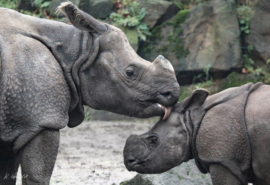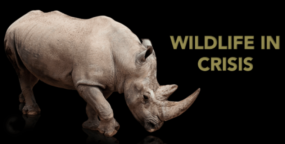Posted on 28 Feb 2019
A recent article by former CITES Secretary-General John Scanlon calls for a debate on the way forward internationally in addressing organized wildlife crime in the absence of a global agreement or a universally agreed definition of what wildlife crime constitutes. But are the barriers to achieving a protocol on wildlife crime simply too high to surmount?
John Scanlon was the secretary-general of the Convention on International Trade in Endangered Species of Wild Fauna and Flora (CITES) from 2010 to 2018. He came to CITES with a long history of involvement in environmental-law issues. During his time at the helm of the convention (I reported to him as lead official on enforcement matters for part of that period), Scanlon raised the profile of the organization in an almost unprecedented fashion. His tenure as secretary-general coincided with a growing appreciation by the international community, and especially the diplomatic, political and law-enforcement entities, of the rapid growth in illegal wildlife trade (IWT). He recognized that it was vital to work collaboratively with a wide range of partners. Indeed, by the time he decided to leave CITES, Scanlon had become very much the global face of combating wildlife crime.
In an article published on 18 February, ‘Do we need a wildlife crime convention’, Scanlon has opened up once again an important debate that we need to have: what should be the response to organized wildlife crime and do we need an internationally binding convention to address IWT? His article provides an objective assessment of the shortcomings of our current responses to wildlife crime. Among these, as Scanlon notes, CITES is not a crime-related convention; does not oblige countries to criminalize illegal wildlife trade; and is not a natural forum for the enforcement or wider criminal-justice community.
One of the conclusions he reaches is that ‘a comprehensive legally binding regime for tackling wildlife crime, within the framework of international criminal law rather than trade law, is beyond the scope of CITES’.
Despite the constructive initiatives he highlights (several of which Scanlon was instrumental in establishing or promoting) – including the International Consortium on Combating Wildlife Crime (ICCWC) and three resolutions on wildlife trafficking adopted by the UN General Assembly, one can infer from his article a sense of frustration that efforts to date appear not to have produced the desired fruits – a significant reduction in IWT and bringing to justice those responsible for it.
What, then, should be the way forward in addressing the threat of IWT? As Scanlon said shortly before the first UN Environment Assembly, in 2014: ‘Ultimately, this fight will be won or lost on the front lines, whether in the field, the courtroom, or the market place – not in a conference room.’
A convention, or a serious conversation around IWT?
Although the word ‘convention’ appears in the title of his recent article, Scanlon suggests it is rather some form of international agreement on wildlife crime that should be established. In particular, he sets out the potential advantages that could be gained through the creation of a protocol to the UN Convention against Transnational Organized Crime (UNTOC). From the outset, though, Scanlon acknowledges this would not necessarily be a panacea for the problem, and he questions whether such a move would even enhance the overall enforcement effort. Either way, the time has come for a ‘serious conversation around the topic’.
Part of that conversation needs to ask the question, would a protocol actually make a difference? It has been mooted over the years that the time is ripe for a wildlife-crime-related protocol to UNTOC. Many, however, would argue that such a route is not necessarily the appropriate one to take – for various reasons.
Firstly, some government representatives and intergovernmental organizations have already discussed the concept of a wildlife-crime-related UNTOC protocol. The views expressed have run the gamut from outright opposition to lack of enthusiasm, to reservations regarding the practicalities that would be needed to achieve such a goal. Some of those who know UNTOC and its diplomatic and administrative processes have, for several years, questioned its effectiveness and the adequacy of its implementation. For example, it has taken years for the Conference of the Parties to create a review mechanism for UNTOC, and the mechanism that was agreed to in late 2018 is seen by a number of commentators as being far from ideal. Arguably, then, it is unlikely that the parties would have an appetite for any additional protocols. And even if there were such a desire, the drafting and final adoption of such a protocol are, realistically, likely to take several years.
One of the other major hurdles in drafting a protocol on IWT would be around how to define the term ‘wildlife’. Many incorrectly assume the word refers only to animals, regardless of the fact that CITES relates to fauna and flora, including trees and fish. Hence, CITES is also relevant for illegal logging, illicit trade in timber, and illegal, unreported and unregulated fishing. For decades, CITES has experienced a reluctance on the part of many states to list certain timber and fish species in its appendices, and a proposal to criminalize illicit trade in such commodities may well deter some governments.
Linked to this is the thorny legalistic matter of defining ‘wildlife crime’. UNTOC defines ‘serious crime’ as being conduct that attracts a minimum threshold penalty of four years’ imprisonment, and CITES parties have been encouraged to treat wildlife crime as serious crime. How likely is a consensus to be reached, across the globe, as to what type of wildlife-related crime justifies such a penalty?
In Scanlon’s mind, one potential positive factor emanating from a protocol is that it would at least oblige countries to criminalize wildlife crime: firstly, it would impose the requirement for states to respond legally and, secondly, it may help encourage increased political will to combat wildlife crime.
However, one could argue that the political will has already been built up, and that it is the collective will to translate that consensus into meaningful and impactful investigations and prosecutions for wildlife crime that is lacking. After all, as now deceased Bob Anderson, the well-known US Department of Justice environmental-crime prosecutor, always said, ‘law without enforcement is just advice’.
Following the road that Scanlon maps out is unlikely to do any harm, and it might, given sufficient time, do some good. It makes sense to close gaps and strengthen legislation, be that at the national or international level. Nevertheless, what we perhaps most urgently need to do in the meantime is, somehow, oblige countries to combat wildlife crime and trafficking. How they do so in their own jurisdictions is perhaps of lesser importance, but the need for a debate around that is pressing.
Identifying the most effective forum for designing and agreeing responses to organized crime as a whole, let alone wildlife crime, is an issue that the international community continues to struggle with. If one accepts that CITES is not the natural forum for the enforcement and criminal-justice community, where should that conversation take place? And who should participate? To date, the ICCWC’s mandate has essentially been restricted to supporting governments in their response to wildlife crime. Is it time for the ICCWC to engage more actively in strategy- and policy-setting, or at least to suggest possible ways forward?
The most important message in ex-CITES Secretary-General John Scanlon’s article is that the time has come for a serious conversation. Drafting the protocol may have to wait for another day.
photo: © Claudio Landi



